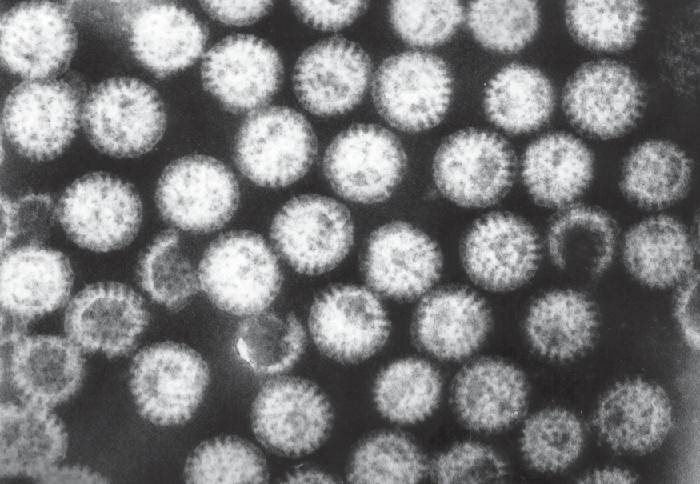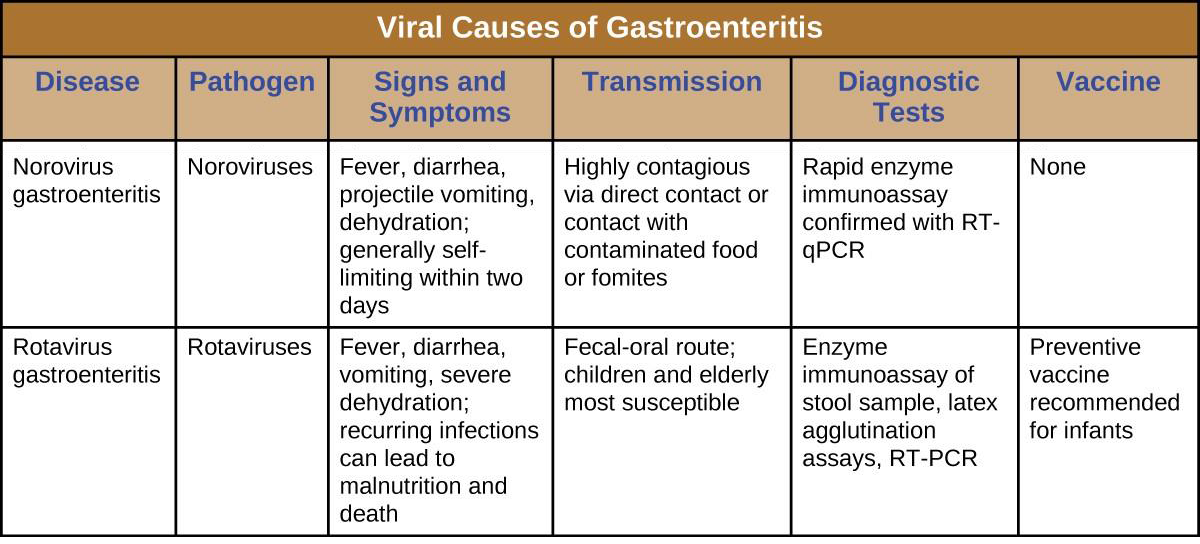19.4 Viral Infections of the Gastrointestinal Tract
Learning Objectives
- Identify the most common viruses that can cause infections of the GI tract
- Compare the major characteristics of specific viral diseases affecting the GI tract and liver
In the developing world, acute viral gastroenteritis is devastating and a leading cause of death for children.[1] Worldwide, diarrhea is the second leading cause of mortality for children under age five, and 70% of childhood gastroenteritis is viral.[2] As discussed, there are a number of bacteria responsible for diarrhea, but viruses can also cause diarrhea. E. coli and rotavirus are the most common causative agents in the developing world. In this section, we will discuss rotaviruses and other, less common viruses that can also cause gastrointestinal illnesses.
Gastroenteritis Caused by Rotaviruses
Rotaviruses are double-stranded RNA viruses in the family Reoviridae. They are responsible for common diarrheal illness, although prevention through vaccination is becoming more common. The virus is primarily spread by the fecal-oral route (Figure 19.14).

These viruses are widespread in children, especially in day-care centers. The CDC estimates that 95% of children in the United States have had at least one rotavirus infection by the time they reach age five.[3] Due to the memory of the body’s immune system, adults who come into contact with rotavirus will not contract the infection or, if they do, are asymptomatic. The elderly, however, are vulnerable to rotavirus infection due to weakening of the immune system with age, so infections can spread through nursing homes and similar facilities. In these cases, the infection may be transmitted from a family member who may have subclinical or clinical disease. The virus can also be transmitted from contaminated surfaces, on which it can survive for some time.
Infected individuals exhibit fever, vomiting, and diarrhea. The virus can survive in the stomach following a meal, but is normally found in the small intestines, particularly the epithelial cells on the villi. Infection can cause food intolerance, especially with respect to lactose. The illness generally appears after an incubation period of about two days and lasts for approximately one week (three to eight days). Without supportive treatment, the illness can cause severe fluid loss, dehydration, and even death. Even with milder illness, repeated infections can potentially lead to malnutrition, especially in developing countries, where rotavirus infection is common due to poor sanitation and lack of access to clean drinking water. Patients (especially children) who are malnourished after an episode of diarrhea are more susceptible to future diarrheal illness, increasing their risk of death from rotavirus infection.
The most common clinical tool for diagnosis is enzyme immunoassay, which detects the virus from fecal samples. Latex agglutination assays are also used. Additionally, the virus can be detected using electron microscopy and RT- PCR.
Treatment is supportive with oral rehydration therapy. Preventive vaccination is also available. In the United States, rotavirus vaccines are part of the standard vaccine schedule and administration follows the guidelines of the World Health Organization (WHO). The WHO recommends that all infants worldwide receive the rotavirus vaccine, the first dose between six and 15 weeks of age and the second before 32 weeks.[4]
Gastroenteritis Caused by Noroviruses
Noroviruses, commonly identified as Norwalk viruses, are caliciviruses. Several strains can cause gastroenteritis. There are millions of cases a year, predominately in infants, young children, and the elderly. These viruses are easily transmitted and highly contagious. They are known for causing widespread infections in groups of people in confined spaces, such as on cruise ships. The viruses can be transmitted through direct contact, through touching contaminated surfaces, and through contaminated food. Because the virus is not killed by disinfectants used at standard concentrations for killing bacteria, the risk of transmission remains high, even after cleaning.
The signs and symptoms of norovirus infection are similar to those for rotavirus, with watery diarrhea, mild cramps, and fever. Additionally, these viruses sometimes cause projectile vomiting. The illness is usually relatively mild, develops 12 to 48 hours after exposure, and clears within a couple of days without treatment. However, dehydration may occur.
Norovirus can be detected using PCR or enzyme immunoassay (EIA) testing. RT-qPCR is the preferred approach as EIA is insufficiently sensitive. If EIA is used for rapid testing, diagnosis should be confirmed using PCR. No medications are available, but the illness is usually self-limiting. Rehydration therapy and electrolyte replacement may be used. Good hygiene, hand washing, and careful food preparation reduce the risk of infection.
![]()
- Why are rotaviruses and noroviruses more common in children?

- Caleb K. King, Roger Glass, Joseph S. Bresee, Christopher Duggan. “Managing Acute Gastroenteritis Among Children: Oral Rehydration, Maintenance, and Nutritional Therapy.” MMWR 52 (2003) RR16: pp. 1–16. http://www.cdc.gov/mmwr/preview/mmwrhtml/rr5216a1.htm. ↵
- Elizabeth Jane Elliott. “Acute Gastroenteritis in Children.” British Medical Journal 334 (2007) 7583: 35–40, doi: 10.1136/ bmj.39036.406169.80; S. Ramani and G. Kang. “Viruses Causing Diarrhoea in the Developing World.” Current Opinions in Infectious Diseases 22 (2009) 5: pp. 477–482. doi: 10.1097/QCO.0b013e328330662f; Michael Vincent F Tablang. “Viral Gastroenteritis.” Medscape. http://emedicine.medscape.com/article/176515-overview. ↵
- Centers for Disease Control and Prevention. “Rotavirus,” The Pink Book. Updated September 8, 2015. http://www.cdc.gov/vaccines/ pubs/pinkbook/rota.html. ↵
- World Health Organization. “Rotavirus.” Immunization, Vaccines, and Biologicals. Updated April 21, 2010. http://www.who.int/immunization/topics/rotavirus/en/. ↵

